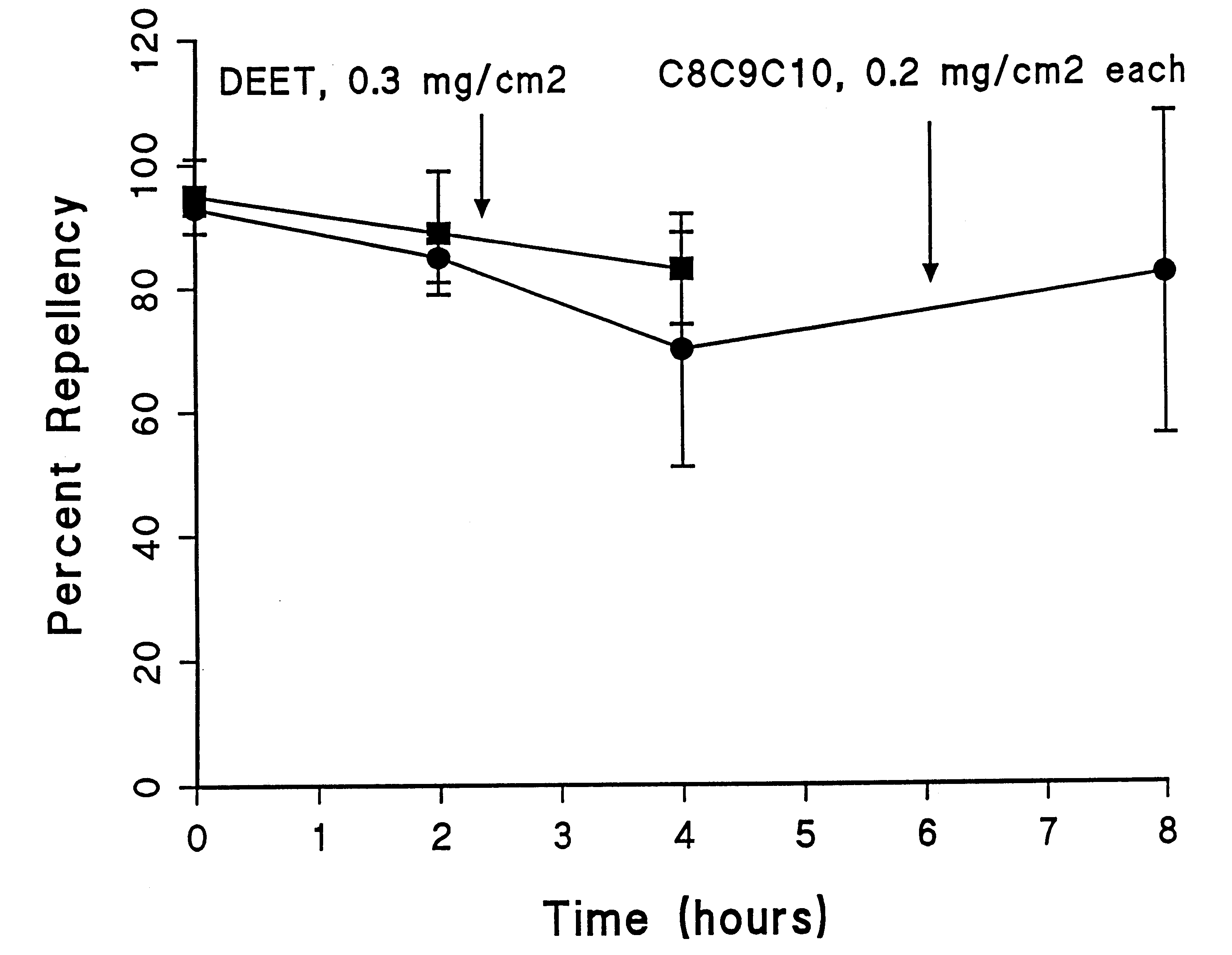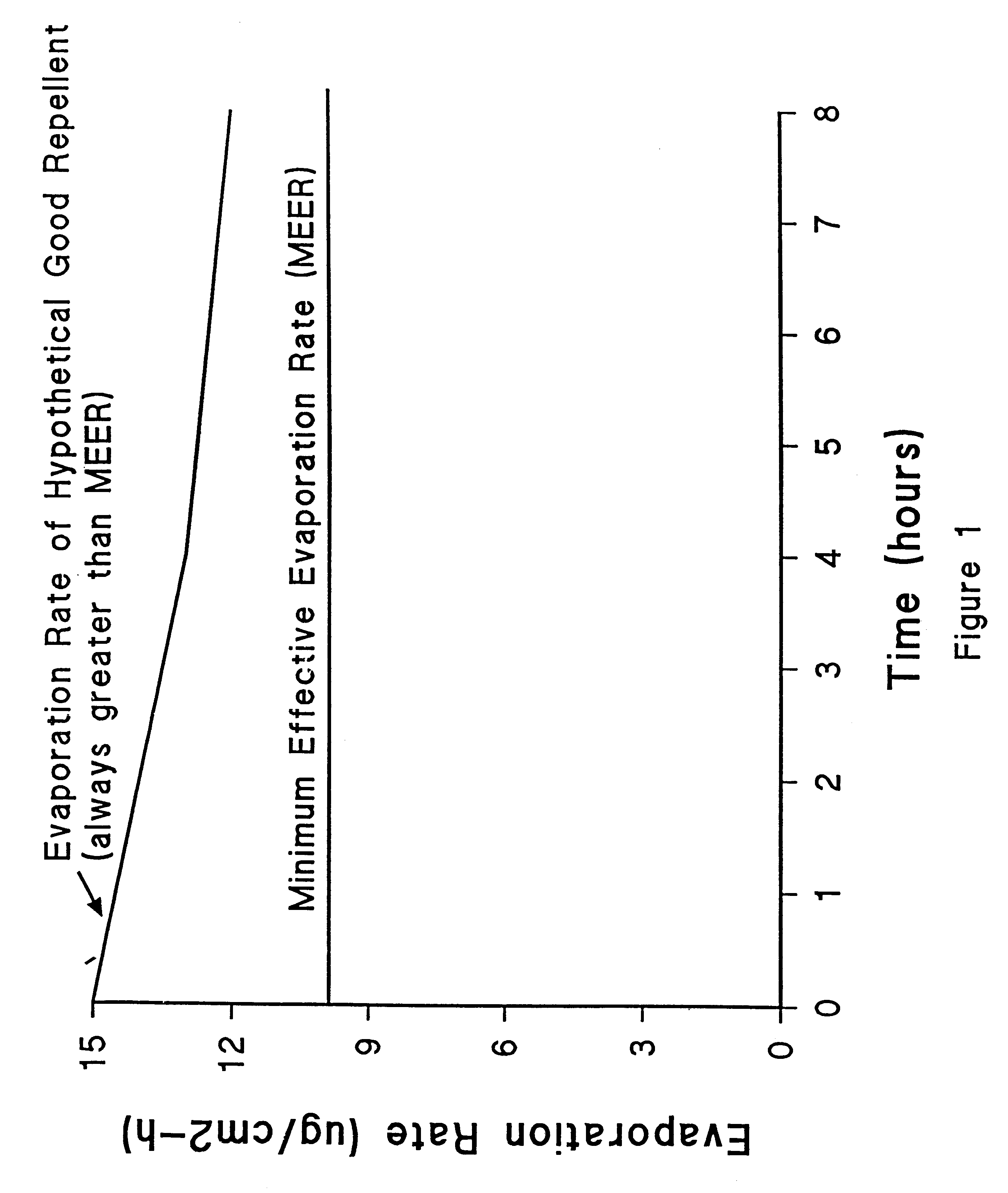Natural insect and arthropod repellent
a technology of arthropods and natural insect repellents, which is applied in the field of insect and arthropod repellents, can solve the problems of low user acceptability of deet formulations, synthetic chemicals with limited activity spectrum and unpleasant odor, and excessive use of deet could pose some risks, etc., and achieves the effects of long-lasting, safe, effective and pleasant
- Summary
- Abstract
- Description
- Claims
- Application Information
AI Technical Summary
Benefits of technology
Problems solved by technology
Method used
Image
Examples
example 1
Identification of Natural Insect Repellent Compounds on Human Skin
Olfactometer: A Fiensod and Spielman olfactometer, as modified by Bowen and Davis, measured the host-oriented flight response of female mosquitoes to volatile host emanations (Feinsod, F. M., and A. Spielman; An olfactometer for measuring host-seeking behavior of female Aedes aegypti (Diptera: Culicidae); J. Med. Entomol., 15: 282-285, 1979). The olfactometer (approximately 38 cm high) consisted of an upper and lower screened chamber with a closure between the chambers (FIG. 8). A fan placed above the upper chamber drew air through the apparatus at approximately 0.2 m / s. A temperature and humidity controlled chamber (5' wide by 6' long by 8' high) was constructed to house the test subject and the olfactometer.
Fearing of Mosquitoes: A second environmental chamber, maintained at 27.degree. C. and 80% humidity, was dedicated to the rearing of Aedes aegypti mosquitoes. Routine shipments of eggs (American Biological Supply...
example 2
Assay of Compounds for Mosquito Repellency on Gauze or Polyester Film
Test compounds were dissolved in acetone or ethanol at a concentration of 150 mg / 5cc. Ethanol solutions of carboxylic acids were prepared just prior to use. Five hundred microliters of these solutions were applied to a 50 cm.sup.2 circular area of a single layer of cotton gauze (Curity Curad gauze, Futuro Inc., Milford, Ohio) or nonwoven polyester film (Reemay 2250, Reemay / Tycon, Inc.). The resultant dose was 0.3 mg / cm.sup.2.
Treated gauze or film was allowed to dry in a hood for 3 minutes prior to placement in a cylindrical stainless steel cup (9 cm in diameter and 3 cm in height), whose bottom consisted of stainless steel screen. The cup was attached to the bottom of the olfactometer (FIG. 8) so that air flowed through the stainless steel screen of the cup, through the treated gauze or film, and through the olfactometer. A volunteer's forearm was placed under the cup, so that air drawn into the cup and olfactomete...
example 3
Assay of Compounds for Mosquito Repellency on Skin
Test compounds were dissolved in acetone or ethanol at a concentration of 300 mg / 5cc. Ethanol solutions of carboxylic acids were prepared just prior to use. Three hundred and fifty microliters of these solutions were applied to a 70 cm.sup.2 rectangular area of the forearm. The resultant dose was 0.3 mg / cm.sup.2. The repellent treated area was allowed to dry for 5 minutes prior to test. The treated skin area was placed under the olfactometer and tests were conducted as described in the preceding paragraph, "Assays for attraction of mosquitoes to human subjects". Percent repellency was determined from the fraction of mosquitoes entering the lower chamber over a seven minute period.
A number of compounds were preliminarily investigated for their ability to act as mosquito repellents after topical application (Table 7). Some of the more volatile acids (octanoic acid and 4MOCTAN) had mean repellency (87-93%) that was competitive with that...
PUM
| Property | Measurement | Unit |
|---|---|---|
| Time | aaaaa | aaaaa |
| Linear density | aaaaa | aaaaa |
| Linear density | aaaaa | aaaaa |
Abstract
Description
Claims
Application Information
 Login to View More
Login to View More - R&D
- Intellectual Property
- Life Sciences
- Materials
- Tech Scout
- Unparalleled Data Quality
- Higher Quality Content
- 60% Fewer Hallucinations
Browse by: Latest US Patents, China's latest patents, Technical Efficacy Thesaurus, Application Domain, Technology Topic, Popular Technical Reports.
© 2025 PatSnap. All rights reserved.Legal|Privacy policy|Modern Slavery Act Transparency Statement|Sitemap|About US| Contact US: help@patsnap.com



